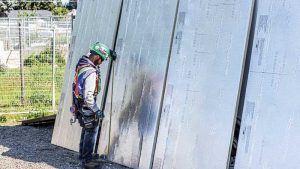By Jen Frey

Preventing moisture intrusion in buildings is not a new challenge for owners, architects, specifiers and contractors, and manufacturers have developed many product solutions to meet this need. However, as the industry has advanced, so have changes to codes and materials, which have allowed innovative approaches to delivering some of the highest performing building envelope solutions, including water-resistive barriers (WRBs) and polyiso (polyisocyanurate or PIR, thermoset plastic foam) continuous rigid thermal wall insulation.
Foam insulation board, such as polyisocyanurate (polyiso), can perform both functions when properly installed as an exterior continuous wall insulation. Polyiso is a rigid insulation board consisting of a closed-cell, thermoset foam core sandwiched between two durable facers. Its versatility, superior thermal performance, and moisture resistance make it widely used in residential and commercial construction markets for both roof and wall applications. When installed on the exterior of the base wall, its multifunctional performance helps mitigate thermal bridging while providing an effective drainage plane that can reduce complexity in wall designs.
The proper specification of WRBs and polyiso can help offset the necessity for building managers to have to control water and moisture permeation within wall assemblies due to hurricanes and heavy rainstorms, slow leaks, precipitation, and condensation which can cause extensive damage, aesthetic impacts, poor indoor air quality (IAQ) and mold growth, that are proven to have harmful effects on the health and well-being of building occupants. In fact, according to the environmental consulting firm, OCCU-TEC, at least 45 million buildings in the U.S. have unhealthy levels of mold, and, many building lawsuits are related
to the building envelope. Intrusion of water into buildings can happen slowly and can remain unseen for a long time. Michael T. Kubal, who
has served as chief operating officer of A. J. Jones Construction Company, one of the largest construction firms in the U.S., noted in his Construction Waterproofing Handbook: “As much as 90 percent of all water intrusion problems occur within one percent of the total building or structure exterior surface area.”3




